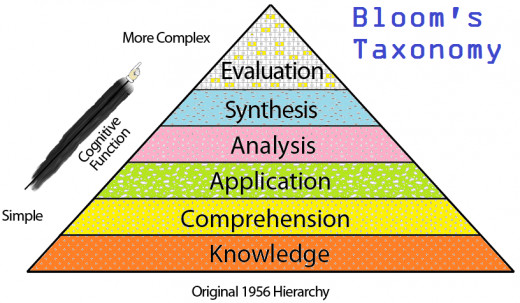Benjamin Bloom and his Tuxedo Taxonomy
Why did Bloom use the word “taxonomy”?
If you apply the taxonomy to psychometric testing as part of your job, you are one of the few professions that won’t have to turn off the ‘work switch’ at the end of a day!
In 1956 Benjamin Bloom and his team published the first of three handbooks detailing how to master a subject, instead of simply recalling a series of facts. A specialist in setting examinations, Bloom chaired an American education and psychology committee determined to raise standards by developing a system that categorized learning behaviour. Then, from a detailed list of ‘laddered’ descriptors, tasks could be set that measured increasing complexity.
Bloom believed higher scores attributed to advanced levels of reasoning made an accurate way of assessing talented students and accurately identifying potential talent. Everyone operated using “cognition” or “thinking”, and as mass-education of the American population was now a government priority, perhaps Bloom reasoned it was time to move on from valuing a person’s usefulness based on what facts they could recall.
Charles Dickens novel Hard Times (1854) and the famous “facts” quote encapsulated 19th century attitudes to educating the “common folk”: “Now, what I want is Facts. Teach these boys and girls nothing but Facts. Facts alone are wanted in life. Plant nothing else, and root out everything else. You can only form the minds of reasoning animals upon Facts; nothing else will ever be of any service to them.” Gradgrind.
It is interesting Bloom pushed for the word “taxonomy” be applied to his Taxonomy of Educational Objectives: the classification of educational goals; Handbook I: Cognitive Domain. (1956). “Taxonomy” is a biological classification of a system of processes; hardly something that applied to psychology. Bloom might have “strayed from the brief” given by the commissioning body, the 1948 Convention of the American Psychological Association, in classifying educational goals and objectives into a “taxonomy”:
• The cognitive - knowledge based domain, consisting of six levels – Handbook I (1956)
• The affective - attitudinal based domain, consisting of five levels - Handbook II: Affective Domain (1965)
• The psychomotor - skills based domain, consisting of six levels – Handbook III never reached publication. Other theorists took up this work (Dave 1970; Harrow 1972, and Simpson 1972)
Perhaps Bloom identified with the idea that people are more than subservient animals, and apply their minds in a way that solves problems. This focus on problem-solving as the outcome of an education led to the discovery that individuals could master any subject with the right set of educational goals and objectives in place.
Today people still quote the phrase: “Jack of all trades, master of none”. The origin of this saying goes back to the 14th century description of commoners who possessed little education or opportunity to advance. Limited access to education and resources used in teaching – (the printing press did not exist) – meant this derogatory term might be something that irritated Bloom, as he sat in parlours discussing the brief with 1950s educationalists. A key question could have been if it was actually true that some people could never attain “mastery”.
Like most great minds, it would seem that Bloom identified something we all knew anyway. Everyone’s an expert in something.
Marketing "Experts"

Why Does Bloom’s Taxonomy Work?
Handbook I is the most famous, and oft-quoted work, when cognitive thought processes are applied to education and training resources. How could someone come up with a theory that seems so obvious to us all now? Is it possible everyone uses Bloom on a day-to-day basis, without realising it?
The Bloom Audit
In meeting new friends polite discussion ensues that is “light” and “conversational”. Over time, less fact-swapping, and more reasoned conversation results. When Bloom met his educationalist friends, asked to compose a set of educational learning styles that would fit every student living in America, they took on a massive task. How could they compose a generic model that would satisfy both educationalists who want to measure, and psychologists who wanted transformation?
Bloom and his colleagues realised the answer was staring them in the face as they sat in their tuxedos contemplating ‘mastery’.
When was the last time you went “deep” with a friend?
Suppose you join a dinner party conversation where no-one has met you before? Think back to the times this has happened to you. Chances are you’ve experienced the “Bloom Audit”.
Bloom’s taxonomy can be compared to a ladder, where tasks involving mental processes and thinking become progressively more difficult as you move up the ladder.
Bloom's Taxonomy Ladder

Six Bloom's Taxonomy Steps Analysed and Explained
Step 1 on the taxonomy “ladder” is KNOWLEDGE: to state, recall, define, describe.
If you are interested in taking social interaction beyond step 1 of Bloom’s Taxonomy, you might ask someone a question like – “So, what did you think of the budget?” – leaving out the word ‘government’ or ‘the party’ or other identifiers to see what level of cognition is on offer. You might be able to go all the way up Bloom’s ladder on this subject, but you won’t speak further with a new friend if their answer is “What budget?” You’ll probably think inside your mind “... ok, back to the topic of the weather ...” Step 1 of Bloom’s Taxonomy has helped you identify that the person you are talking to has little to no mastery of the subject you raised.
Step 2 is COMPREHENSION: explain, interpret, classify, re-organize.
If you’ve reached this level of table-talk with another, you’ve got someone hooked who appears to have some knowledge. You might have asked, (again leaving out some ‘cues’), “What do you think of Emily Thorne?” Among a certain segment of fashionable women, the character “Emily Thorne” of TV series “Revenge” is as well known as Bloom’s Taxonomy is to schoolteachers. If you get a stage 2 answer back, you can go further up the ladder and secure more meaningful social dialogue.
Possible answers to the “Emily Thorne” inquiry could be:
- · “She’s the one from Revenge isn’t she?” – this is still step 1 on the taxonomy as it is ‘defining’.
- · “Oh I just love her!” – this is a step 2 response ‘classifying’ the character as loved.
- · “She’s a post-punk type heroine!” – step 2 – “re-organizing” your inquiry – Potentially we could converse up the taxonomy!
- · A general description of the latest episode and plots – step 2 – explaining and interpreting.
Polite conversation at dinner parties is an excellent way to practice scaling your conversations up according to Bloom’s Taxonomy. For instance, you would seem awfully boorish if you suddenly replied to these statements with; “to me, Emily Thorne is a fashion icon, an antithesis to moody austerity, yet at the same time, a re-cycling of that old social model: consume fashion and look good to get ahead in the world.” You might find your listener rapidly excusing themselves to get another drink/ring their nanny/speak to their boss/speak to anyone but you! This is because you jumped to Step 6, evaluating the subject, prematurely.
Step 3 is APPLICATION – apply, use, calculate, punctuate.
To show a polite progression using the taxonomy, consider popular music artist Rihanna as a topic:
Step 1 – “What’s your favourite musician right now?” and answer “Rihanna”. Topic defined.
Step 2 – “Why Rihanna?” and answer “She is so great and has a lot of top-selling hits so she’s musically very successful.” – interpretation.
Step 3 – “So what are your favourite Rihanna songs and why?” – here you elicit ‘application and calculation” as your listener needs to apply their knowledge of Rihanna to explain how they use her musical spectrum in life. Conversation can stay at this level in the taxonomy for a while, following up with questions like “How long have you been a fan?” The application of knowledge stretches the table-talk into an area where your new friend recognises the components of their subject, recalls facts, classifies and organises the information, and presents to you in an applied way.
These 3 steps are known as Reproduction or Mastery Tasks in Bloom’s Taxonomy, which anyone can demonstrate. It is interesting that many social conversations halt at this stage with interpersonal roadblocks like “that was really interesting”. Most of us evaluate at this point if we have anything in common with our listener, and the idea of having “something in common” is a curious expression in itself if you consider Bloom’s Taxonomy established that we are all expert, and far from common.
So how do you get someone to analyse Rihanna?
Step 4 – ANALYSIS – consider the parts separately, analyse a situation, experiment or write a case study and describe what is happening. Compare, give reasons, cause and effect, categories, deduce.
A good question to get your listener going further and testing their intellectual understanding of Rihanna is to ask them “Why do you think she’s been so successful in her career?”
Obviously, you can see that you would have to be actually interested in the answer in order to judge if your speaker had any specialist or detailed knowledge.
This is an important shift in conversing on a social level. You are now climbing Bloom’s “Reproduction and Reasoning” stages of the taxonomy ladder, which can give away a lot about how educated someone is. This can be applied to any area of conversation, and surprisingly, is what you’ve experienced during interviews with potential employers, who are assessing how expert you are for their organisation. So Bloom’s Taxonomy is applied naturally by skilled HR people to elicit your expertise and intellectual skills and abilities. A HR question could form as “Why do you think our competitor X has secured such a large market share?” So the interviewee needs to reproduce some accurate knowledge about the competition, form their response by interpreting the success experienced, apply factual instances of that success and then (step 4) give a cause and effect argument.
Ever been shut out of a dinner party conversation about politics? It might be that other speakers realised when at step 4 in Bloom’s Taxonomy that your table-talk wasn’t up to muster!
Step 5 – SYNTHESIS – create, design, invent, solve a problem, report, criticise, give constructive suggestions – improvements/policies/devices.
By now the tuxedo-wearers are gathered, the cigars and brandies are out, and the conversation has moved to Step 5. Imagine yourself part of a conversation about the US Federal Reserve with a rapid exchange of views. Topics include FR ownership, Monetary Policy, the sub-prime crisis, and require a higher-ladder thought process if you are to scale Bloom’s Taxonomy. If you gain access to this kind of conversation at a social occasion, you are talking with someone or a group you have a lot in common with, and searching for common intellectual ground. Successful conversations like this make us feel a sense of enjoyment at our place in the world. Our expertise was exercised.
For Bloom’s educationalists, what they found exciting was the idea that learners could be similarly stimulated, if moved up the ladder as educational goals were met. Material could be planned by teachers that became progressively complex. The label “Progressive Education” came into usage after Bloom published his first Handbook and the concept endures today with projects such as “No Child Left Behind”.
Psychologically, bringing groups to the level of Reproduction and Reasoning on the taxonomy ladder, where they formed interesting and individual creative arguments, tapped into ideas formed by Ernest Jones’ new science of mind movement. Jones proposed humans were "open at the top"— or open to evolutionary improvement of consciousness in all areas of life.
Interestingly, Bloom’s theory proposed ideas similar to “universal consciousness”. If learners took more active and conscious control over understanding, the education of society would vastly improve. His taxonomy was a systematised way of ordering that consciousness into a cognitive plan that stimulated higher thinking. Additionally, it was a way to assess, measure and reward that thinking.
Step 6 – EVALUATION – judge, critically appraise, for and against, strengths and weaknesses, fitness for purpose, evaluate.
Back to our dinner party conversation ... You can appreciate when the group moves into the evaluation stage of the taxonomy there might be arguments! Earlier on in this article I said Bloom’s taxonomy could be described by the phrase “When was the last time you went ‘deep’ with a friend?”
We can all recall conversations that have satisfied and taught us something new. If you think about it, they will have been conversations that led to evaluation cognitive/thinking processes. These conversations will have formed through polite friendship, where together you climbed the ladders of Bloom’s Taxonomy.
These are the friends we value, hang on to, and swap numbers with.
For Bloom, his goal in writing the taxonomy was to foster a love of learning for life. Education is a good ‘friend’. We must accept that Bloom would have made an excellent dinner party guest. As Elliot W. Eisner, who wrote a biography of Bloom says, “... one of Bloom's great talents was having a nose for what is significant" (2002).








